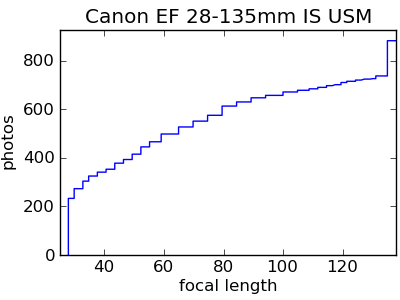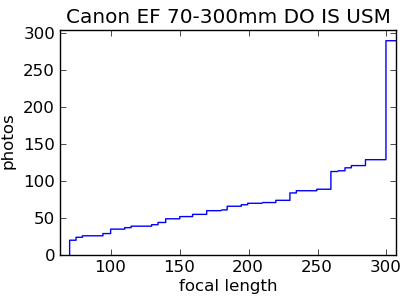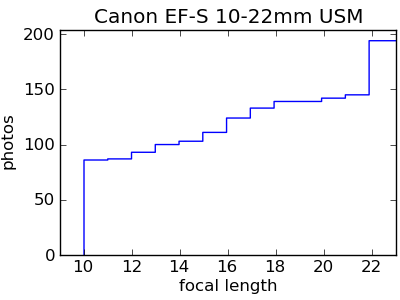Zoom vs. Prime: Focal Length Usage
I recently observed an online discussion of camera lenses. People were debating the merits of zoom vs. prime lenses, falling into the predictable points of flexibility vs. performance. One of those defending the merits of prime lenses posited that if one were to plot the usage of focal length with respect to number of photographs taken, the tendency would be for photographs to cluster around the extremes of the focal lengths.
Since I was curious about how I would fall into this range, and decided to run the experiment for myself. As a bit of background, I have a Digital Rebel XT with which I use four lenses:
-
EF 28-135mm IS USM is my midrange general purpose lens. I have this lens mostly because when I got it in 2005, the passable EF-S midrange lenses did not exist yet. I believe it was the right choice for the time, but I can’t pretend that I’d even consider it today. The 28mm is still way too long in a crop sensor.
-
EF 70-300mm DO US USM is my telephoto zoom. For roughly the same price I could have bought the EF 100-400mm L IS USM, but that thing is huge and conspicuous, and I wanted something I could carry everywhere and use without feeling self-conscious, as I’m kind of a shy guy.
-
EF-S 10-22mm USM is my wide angle. If you have a crop sensor and want a wide angle, it’s this or nothing.
-
EF 50mm f/1.4 USM is my only prime. I got this a relatively short time ago when my baby girl was born, and I found my 28-135 utterly inadequate in low light. However, because it is so new, and because the purpose of this analysis is to see which focal lengths I used (in a prime, there’s no choice!), it is not covered in this analysis.
With the help of a small Python script to and EXIF.py, I was able to read and aggregate all of the focal lengths and lens types for a period a couple weeks after I got the 10-22 wide lens, up until the day my daughter was born. Naturally my photographic habits changed with both events, but between these two events my behavior may have been stable. This covered a period of roughly two years, with 1366 photographs. Naturally, these are just the photographs that I did not delete.
In the following plots I give focal length on the horizontal axis, and the number of photographs in the Y-axis in a cumulative histogram. So, pay less attention to the value of the vertical axis, and more to the size of the jumps.

We lead off with my general purpose lens. Unsurprisingly, I do have a tendency to use the entire range of this lens. I have a slight tendency to “top off” at around 80-100mm or so, before having a strong tendency to shoot at the maximum 135mm. The most notable and obvious trend, though, is my heavy usage of the 28mm focal length, perhaps reflecting my frustration with the lens being too long for its own good for my camera body.


Next we have the telephoto and wide angle zooms, in that order. My behavior with these is quite different from my general purpose lens. Indeed, as posited, there is a strong tendency to use the extreme endpoints. I like my longs long and my wides wide, clearly. Nonetheless, I do shoot a substantial amount along the range of both, and I do exhibit a slight tendency to shoot with my telephoto wide (probably because I’m too lazy to swap in the general purpose lens in many circumstances), so clearly I get substantial benefit from the zoom.
I find this quite interesting, not only for the sake of this isolated analysis, but because it seems like there’s a tremendous amount of interesting data we could mine regarding people’s photographic habits if we could just collect everyone’s EXIF tags. What do good photographers do that bad photographers don’t, or vice versa? If we multiplied aperture times ISO times shutter speed, would the resultant value tend to decrease in summer, and increase in winter? What if we could somehow limit the analysis to “good” photographs? It’s unclear whether any of this could be put to any practical worth, but it’s still interesting.